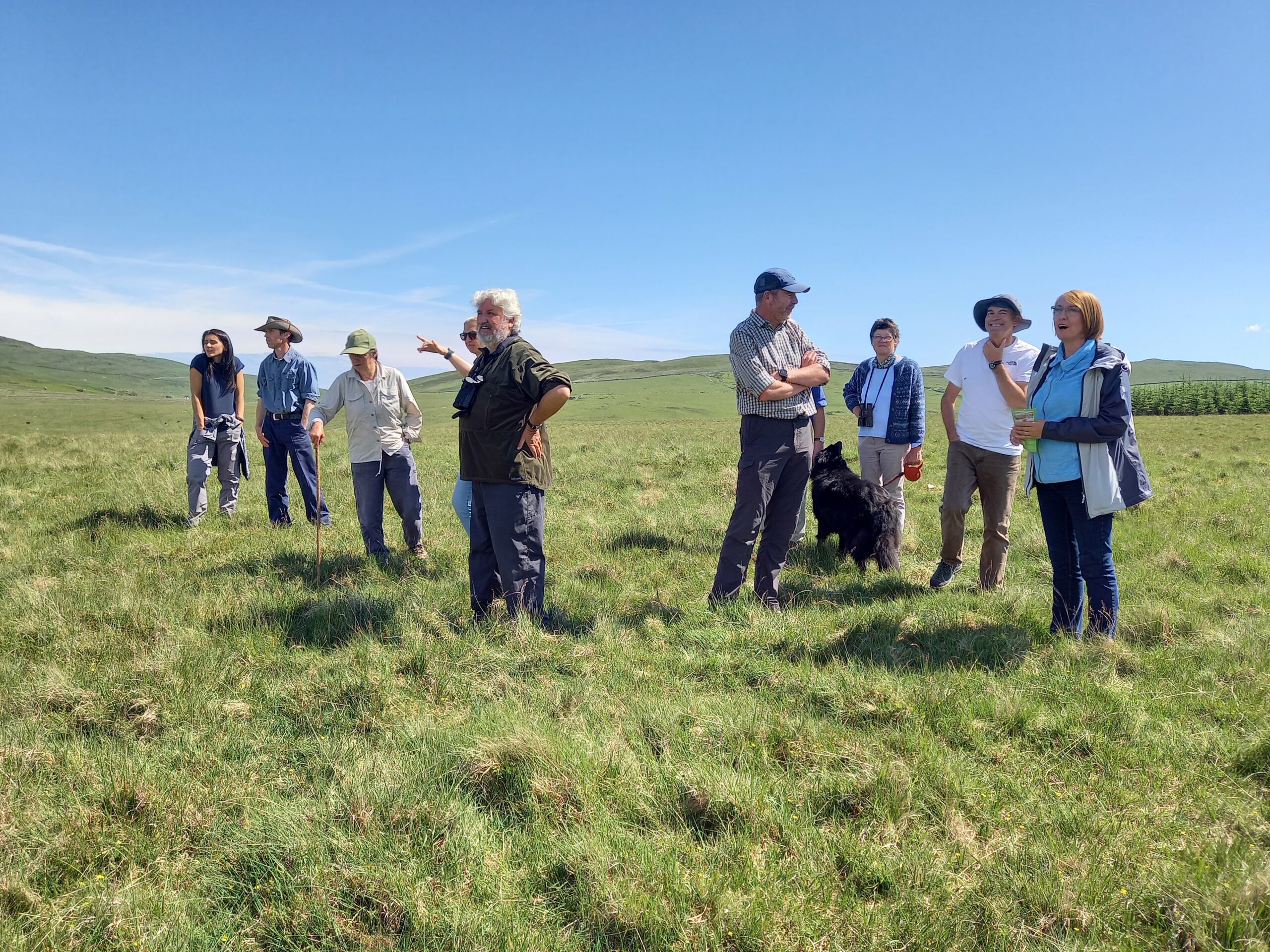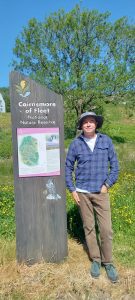Team GSAB and One Sunny Day in June

It was with cautious optimism that GSAB managers had scheduled a series of staff induction days for the benefit of our expanded team, but it turned out the first one was good to go ahead on 18 June. We are luckier than many in that the greater proportion of our work entails being outdoors, in rural places, open spaces, and far away from crowds.
To be perfectly honest, ‘staff induction day’ sounds rather dry and doesn’t do the thing justice. The intent was to bond as a team, and for the new recruits to get to know a few of our partner organisations and Proud Supporters. We’re sure many of you will empathise when we say there’s only so much that can be done via Zoom.
Our outing was blessed with one of the sunniest days of 2021 so far and Gatehouse of Fleet was looking its loveliest for our early car park rendezvous. First stop on the day’s itinerary was a visit to The Mill on the Fleet, a former cotton mill which was adopted, restored and now operated by community volunteers. This beautiful 18th century building is currently home to the Field Names of Borgue exhibition, which marks something of an apex point – one of many, it has to be said – in the PLACE in the Biosphere Project. So far around 800 fields have been mapped across the Borgue peninsula with the participation of 70 locals, volunteers, farmers and land managers, and 1,000 field-names collected and analysed in terms of their history, meaning, and evolution. Coordinated by Project Officer Nic Coombey, the PLACE team hope that this project will continue to intrigue and enchant as we continue to uncover more about how the people who live and have lived in Borgue interact with the natural world.
Being a ‘green thinking’ kinda crew, we masked up to car-share our way to location two: Cairnsmore of Fleet Nature Reserve, where we were met by the NatureScot team. The reserve is perfect for walking, cycling, picnicking, and other pursuits appropriate to a rural idyll in D & G. The peace and beauty of Cairnsmore rather conceals all the work that goes on to manage, optimise and restore the land: examples include finding an environmentally friendly way to rid the area of invasive bracken and promote plant biodiversity, and how to guard against forest fires in wooded areas. Part of NatureScot’s work is to examine how people use Cairnsmore reserve – whether in positive ways or otherwise – and to use both experience and innovation in achieving balance between people and nature. Local residents and tourists alike want to visit Cairnsmore, to eat, sleep, and play there, so how do we make the visitor experience sustainable? What facilities should be provided for comfort and refreshment – anything? Nothing? How do we manage numbers? What is the best way to spread the ‘leave no trace’ ethos? These are questions that come up all the time, all over Galloway and Southern Ayrshire UNESCO Biosphere and finding answers is an essential part of UNESCO’s Man and the Biosphere Programme, which aims to establish a scientific basis for enhancing the relationship between people and their environments.
Cairnsmore of Fleet Nature Reserve, where we were met by the NatureScot team. The reserve is perfect for walking, cycling, picnicking, and other pursuits appropriate to a rural idyll in D & G. The peace and beauty of Cairnsmore rather conceals all the work that goes on to manage, optimise and restore the land: examples include finding an environmentally friendly way to rid the area of invasive bracken and promote plant biodiversity, and how to guard against forest fires in wooded areas. Part of NatureScot’s work is to examine how people use Cairnsmore reserve – whether in positive ways or otherwise – and to use both experience and innovation in achieving balance between people and nature. Local residents and tourists alike want to visit Cairnsmore, to eat, sleep, and play there, so how do we make the visitor experience sustainable? What facilities should be provided for comfort and refreshment – anything? Nothing? How do we manage numbers? What is the best way to spread the ‘leave no trace’ ethos? These are questions that come up all the time, all over Galloway and Southern Ayrshire UNESCO Biosphere and finding answers is an essential part of UNESCO’s Man and the Biosphere Programme, which aims to establish a scientific basis for enhancing the relationship between people and their environments.
Down by the Cairnsmore Visitor Centre is a bit of a suntrap as it turns out,  so we picnicked and tanned for a while – Team GSAB in the company of members of the Biosphere’s Partnership Board. Pictured here on the right in a UNESCO UK exclusive is Andrew Tait, our newest recruit. Andrew will be our Land Use and Biodiversity lead from August and is currently packing up in Cumbria ready for a brand new Biosphere life! Andrew’s passion for the natural world is matched by his experience, reflected in the fact that our conversations on Friday ranged from house-building to tree-planting via Hollie Gillibrand and lynx.
so we picnicked and tanned for a while – Team GSAB in the company of members of the Biosphere’s Partnership Board. Pictured here on the right in a UNESCO UK exclusive is Andrew Tait, our newest recruit. Andrew will be our Land Use and Biodiversity lead from August and is currently packing up in Cumbria ready for a brand new Biosphere life! Andrew’s passion for the natural world is matched by his experience, reflected in the fact that our conversations on Friday ranged from house-building to tree-planting via Hollie Gillibrand and lynx.
Once fed and watered the convoy moved on again, to our third and final stop at Bagbie Farm. Dr Joan Mitchell, Chair of our Partnership Board, farms cattle and sheep at Bagbie with her husband and son, having taken over from her father in 1972. These three generations of farmers have witnessed at the closest possible quarters the rapid changes in local biodiversity that are directly attributable to climate change. Joan and her son Ian were keen to share their stories, particularly which issues inform the choices that Scottish farmers make. Why choose one breed of beef cattle over another? What if one breed is better for rearing and handling by the farmers themselves, but buyers further down the line are not so keen? How is Brexit going to impact day-to-day farming life?
Our discussion at the farm progressed to a tour through the hills, where Joan and Ian explained everything that we could see in terms of boundaries, planting, and interactions with neighbouring farms. We talked about the places where environmental and commercial interests meet, and where they divide.  Also with us on Friday was Partnership Board member Andrew Bielinski, Area Manager for the Scottish Lowlands and Southern Uplands at RSPB Scotland. Joan, Andrew, and the rest of the team were keen to discuss what’s happening to our bird life in south-west Scotland. The fact that birds are the closest living relatives to dinosaurs is well known, but we wonder if that ancient lineage serves them rather badly by concealing just how vulnerable many species are. The consensus among our small group of south-west Scotland observers is that lapwing, curlew, and red kite numbers are down, not just in terms of statistics reported by national agencies but in a way that is starkly apparent to any layperson who’s been in the area a while. Kestrels too are much less frequently seen circling Bagbie Farm than they were in days gone by.
Also with us on Friday was Partnership Board member Andrew Bielinski, Area Manager for the Scottish Lowlands and Southern Uplands at RSPB Scotland. Joan, Andrew, and the rest of the team were keen to discuss what’s happening to our bird life in south-west Scotland. The fact that birds are the closest living relatives to dinosaurs is well known, but we wonder if that ancient lineage serves them rather badly by concealing just how vulnerable many species are. The consensus among our small group of south-west Scotland observers is that lapwing, curlew, and red kite numbers are down, not just in terms of statistics reported by national agencies but in a way that is starkly apparent to any layperson who’s been in the area a while. Kestrels too are much less frequently seen circling Bagbie Farm than they were in days gone by.
Joan’s hospitality continued with an invitation to return to the welcome shade of her garden for tea  and biscuits. Here’s a photo of what Team GSAB looks like post-custard creams, happily fatigued and sprawled on lawn chairs. Our next staff induction day is scheduled for early July when we’ll be up in Ayrshire visiting community groups and Biosphere businesses so we’ll have another feature on that in due course, and please do follow our daily updates on Facebook, Twitter and Instagram to stay informed what we’re up to meantime.
and biscuits. Here’s a photo of what Team GSAB looks like post-custard creams, happily fatigued and sprawled on lawn chairs. Our next staff induction day is scheduled for early July when we’ll be up in Ayrshire visiting community groups and Biosphere businesses so we’ll have another feature on that in due course, and please do follow our daily updates on Facebook, Twitter and Instagram to stay informed what we’re up to meantime.
If you have any questions or comments about the issues raised in this feature please do get in touch at info@gsabiosphere.org.uk. We are keen to gather opinions, experiences and ideas; the UNESCO Biosphere ethos includes learning from each other and sharing best practices. So don’t hesitate to drop us a line and become part of the Biosphere story.
